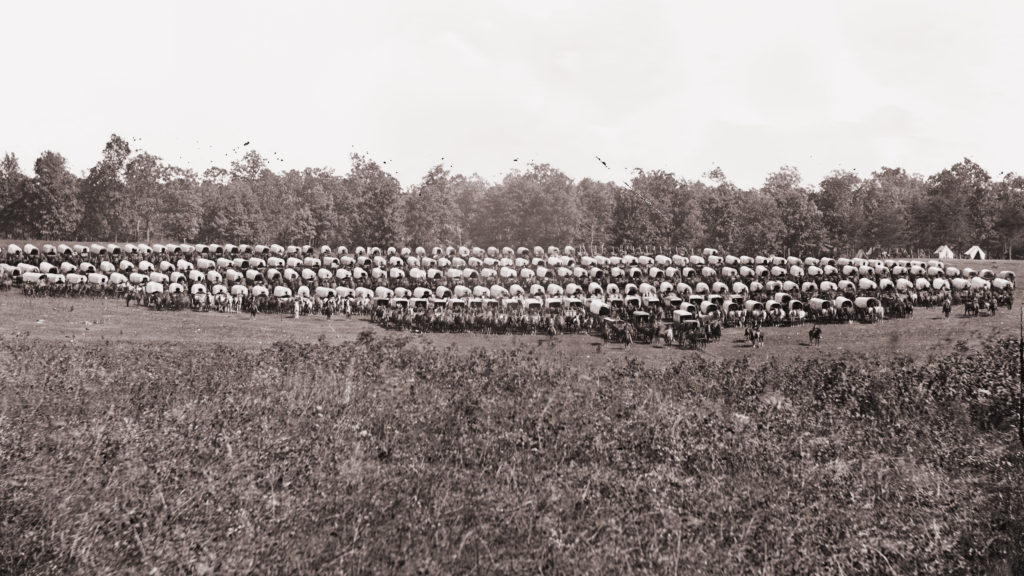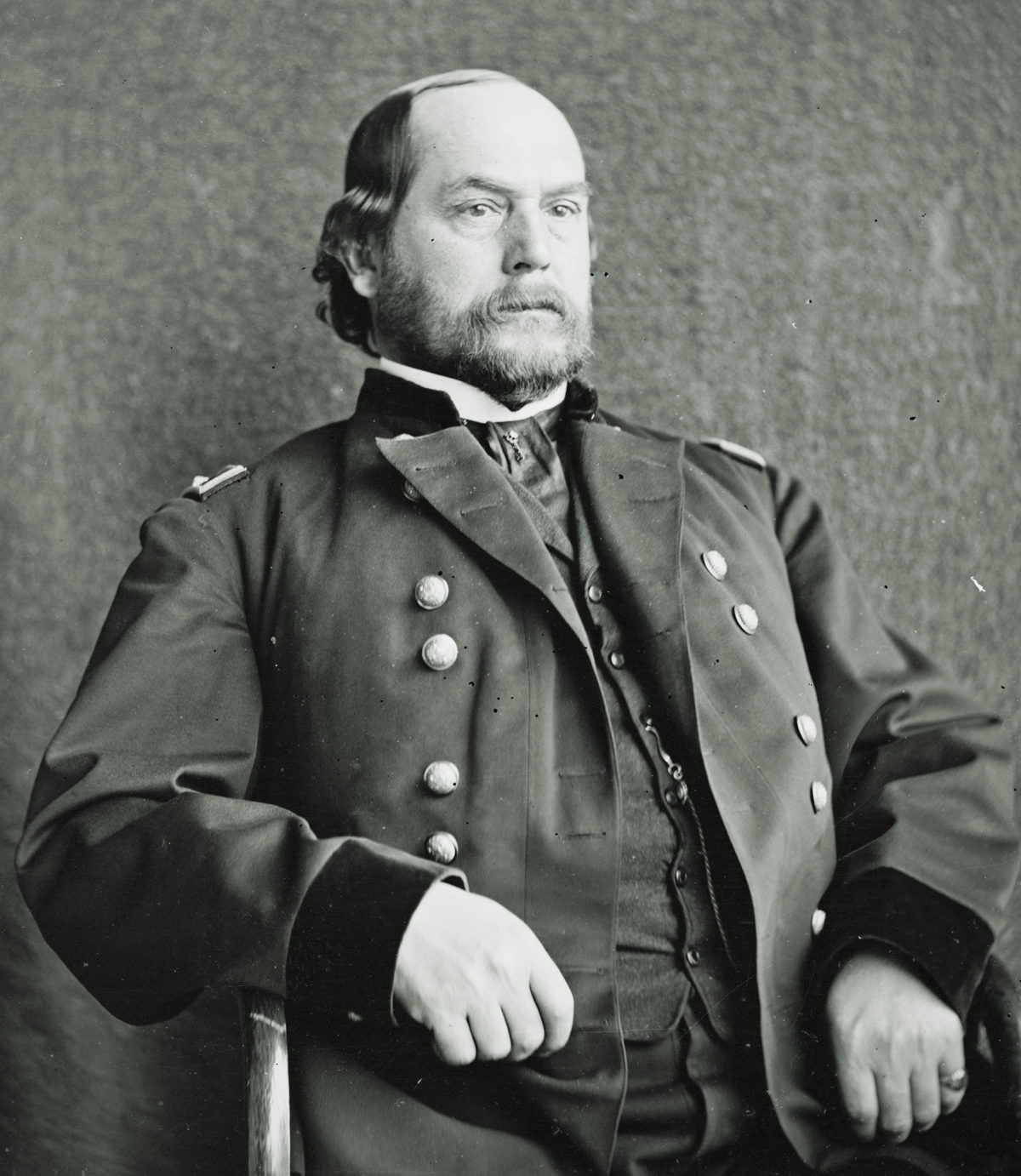During the 1864 Overland Campaign, staff officer Theodore Lyman marveled at the skill of the Army of the Potomac’s chief quartermaster Rufus Ingalls. “How these huge trains are moved over roads not fit for a light buggy, is a mystery known only to General Rufus Ingalls, who treats them as if they were so many perambulators on a smooth side walk.” When Maj. Gen. George McClellan received orders on September 3, 1862, to assemble a field army to meet a possible Confederate invasion of Maryland, Ingalls was perhaps the most important soldier McClellan needed for that to happen. Napoleon purportedly once wrote that an “army marches on its stomach.” Another frequently heard quip is that “amateurs talk strategy, professionals talk logistics.” Both reference the crucial role of logistics in maintaining armies in the field. Soldiers cannot fight without weapons, bullets, and shells, and if they lack food, fuel, clothing, equipment, and transportation the army will soon come apart at the seams as soldiers straggle to meet basic needs, just as thousands of Confederate soldiers did in the Maryland Campaign. A good quartermaster was essential to an army’s ability to fight, and Ingalls was among the best in either army.
Logistics posed an immense challenge for McClellan in assembling an army capable of maneuvering in the field. The Army of the Potomac still had considerable quantities of equipment arriving daily from the Virginia Peninsula, from where they had been withdrawn in August 1862 to reinforce Maj. Gen. John Pope’s Army of Virginia in northern Virginia. Logistics were not Pope’s strength, and his army’s wagon trains were in a muddle even before the defeat at Second Bull Run. Ingalls wrote with unconcealed contempt that it “does not appear that the commander of the Army of Virginia ever knew how many wagons there were, nor what quartermasters were on duty.” The chaotic retreat from Manassas to Washington threw both armies’ trains into even greater confusion.
McClellan relied on Ingalls to untangle the fishing knot encumbering the army’s transportation, because until the army reached Frederick, Md., where it would have rail communications, it would have to be supplied solely by wagons hauling supplies from depots around Washington. To get a sense of the magnitude of the task, the nearly 80,000 men and 32,000 horses and mules required a million pounds of food and forage daily. The complex calculations to haul this quantity of supplies efficiently with horse-drawn wagons to combat units spread across a front of nearly 30 miles can be imagined. Ingalls also had to determine deficiencies in clothing and equipment and do his best to meet the direst situations so units had a basic kit with which to fight. He needed to become familiar with the quartermasters for the 1st, 9th, and 12th Corps—none of whom had operated with the Army of the Potomac—and assess their needs as well as their organizational strengths and weaknesses. It was incessant work and demanded great skills. Ingalls related, without exaggeration: “The labor, however, of arranging and perfecting this system of transportation, of bringing to each depot the requisite amount, and the details of trains for the distribution of these vast supplies to the different portions of the army, was excessively onerous night and day.”

A “violent and destructive disease” that broke out among the army’s horses exacerbated the challenges, taking nearly 4,000 out of service. Despite the haste with which the army had to take the field when the Confederates entered Maryland in early September, Ingalls succeeded in keeping it adequately supplied. Adequate was a relative term, as many soldiers complained of shortages of clothing and equipment. Holmes Burlingame of the 104th New York wrote that his brigade “was in really bad condition, we had been without tents or blankets, with no change of clothing since we left our knapsacks on the field back near Thoroughfare Gap [Va.].” The uniforms “were ragged, our shoes no better,” and numbers lacked socks. Rations were also barely palatable, “unfit to eat almost,” the hardtack, “filled full of little black bugs.”
Ingalls likely would have told a soldier like Burlingame that the quartermasters did the best they could under the circumstances. Clothing and equipment resupply and better quality food would have to wait until the emergency created by the Confederate invasion had passed. The soldiers responded by straggling and foraging, which created its own set of problems for McClellan.
When the army reached Frederick, Ingalls’ problems eased momentarily, as supplies could be transported there by train. But when the army moved west to South Mountain and Antietam, it became necessary to again haul those supplies by wagon, the Rebels having destroyed the railroad bridge over the Monocacy River. Supplies might be carried here by rail, but they had to be unloaded and transferred to wagons. Once the army reached the Antietam battlefield, Ingalls established a depot at Hagerstown, where supplies could be carried via the Cumberland Valley Railroad. From this depot, it was a 13.5-mile haul to the army around Sharpsburg, but this was better than the difficult 22-mile drive from Frederick, crossing Catoctin Mountain and South Mountain, which placed incredible stress on the animals pulling the heavy wagons.
The Union victory at Antietam and retreat of the Confederates to Virginia did not ease Ingalls’ labors. The period of quiet after the battle was spent trying to make good the shortages of which soldiers such as Burlingame complained. Ingalls and his quartermasters worked tirelessly, but the problem with getting clothing, forage, and equipment to the army—now spread out from Sharpsburg to Harpers Ferry—proved maddeningly slow.
Some sense of the task’s magnitude was the fact that the Army of the Potomac was just under half the size of the city of Baltimore’s population of 212,000. It took more than a snap of the fingers to establish a smooth flow of abundant supplies to an army of this size over a transportation system that was not designed to supply so many people and animals in this part of Maryland. Colonel Charles Wainwright, the 1st Corps’ chief of artillery, grumbled on October 10 (nearly a month after Antietam) that the corps had “received next to no supplies, and is just as badly off as directly after the battle.”
The situation slowly improved but hadn’t been entirely sorted out when McClellan, prodded fervently by Lincoln and the War Department, moved his army from its Maryland camps into Virginia to start a new campaign. On November 7, McClellan was replaced by Maj. Gen. Ambrose Burnside, but Ingalls was one McClellan legacy who fortunately remained and would continue to work logistical miracles for the army’s grateful commanders to follow: Burnside, Joe Hooker, and George Meade, as well as U.S. Army General-in-Chief Ulysses S. Grant.
Scott Hartwig writes from the crossroads of Gettysburg.






